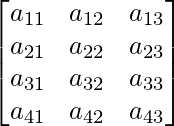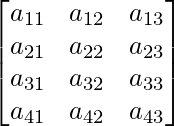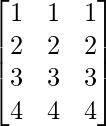问题1:如果一个矩阵有8个元素,它可能具有的阶数是多少?如果它有5个元素怎么办?
解决方案:
Part 1:
Let the matrix be of mxn dimension.
Hence, mxn = 8.
Then, all we have to do is, find the divisors of 8, which are : 1, 2, 4, 8.
Thus, the possible orders are: 1×8, 8×1, 2×4 and 4×2.
Part 2:
Following a similar approach:
Since, mxn = 5.
The divisors of 5 are : 1,5.
Thus, the possible orders are: 1×5 and 5×1.
问题2(i):如果A = [a ij ] =  和B = [b jj ] =
和B = [b jj ] =  然后找到22 + b 21 。
然后找到22 + b 21 。
解决方案:
We know that every element in a matrix A of dimensions mxn can be addressed as aij, where 1≤ i ≤ m and 1 ≤ j ≤ n.
Thus, a22 is the 2nd element in the 2nd row of A, and b21 is the 1rst element in the 2nd row of B.
That implies, a22 + b21 = 4 + (-3) = 1.
问题2(ii):如果A = [a ij ] =  并且B = [b ij ] =
并且B = [b ij ] =  然后找到11 b 11 + a 22 b 22 。
然后找到11 b 11 + a 22 b 22 。
解决方案:
As seen in the previous question, every element in a matrix A of dimensions mxn can be addressed as aij, where 1≤ i ≤ m and 1 ≤ j ≤ n.
Thus,
a11 = 1rst element in the 1rst row of A = 2.
a22 = 2nd element in the 2nd row of A = 4.
b11 = 1rst element in the 1rst row of B = 2.
b22 = 2nd element in the 2nd row of B = 4.
That implies, a11b11 + a22b22 = (2×2) + (4×4) = 4 + 16 = 20.
问题3:设A为3×4阶矩阵。如果R1表示A的第一行,而C2表示其第二列,则确定矩阵R1和C2的顺序。
解决方案:
Given, A is a matrix of order 3×4.
We know that a matrix having an order of mxn has m rows and n columns.
Thus, A contains, 3 rows, and each row contains 4 elements.

Now, if R1 is a row, it has 4 elements, and thus its order can be written as 1×4, ![]()
And similarly, if C2 is a column, it will have 3 rows, each with 1 element, and thus its order is 3×1, 
问题4(i):构造一个2×3矩阵A = [a ij ],其元素a ij由下式给出:a ij = ix j。
解决方案:
We know that A is a matrix of order 2×3.
Thus A can be depicted as: 
Since each element is a product of its row number and column number (i x j):
a11 = 1 a12 = 2 a13 = 3
a21 = 2 a22 = 4 a23 = 6
Thus, A can be depicted as : 
问题4(ii):构造一个2×3矩阵A = [a ij ],其元素a ij由下式给出:a ij = 2i – j。
解决方案:
We know that A is a matrix of order 2×3.
Thus A can be depicted as: 
Since each element can be defined as (2 x (row number)) – column number:
a11 = 1 a12 = 0 a13 = -1
a21 = 3 a22 = 2 a23 = 1
Thus, A can be depicted as : 
问题4(iii):构造一个2×3矩阵A = [a ij ],其元素a ij由下式给出:a ij = i + j。
解决方案:
We know that A is a matrix of order 2×3.
Thus A can be depicted as: 
Since each element can be defined as the sum of its row number and column number:
a11 = 2 a12 = 3 a13 = 4
a21 = 3 a22 = 4 a23 = 5
Thus, A can be depicted as : 
问题4(iv):构造一个2×3矩阵A = [a ij ],其元素a ij由下式给出:a ij =  。
。
解决方案:
We know that A is a matrix of order 2×3.
Thus A can be depicted as: 
Since each element can be defined as :  ,
,
a11 = 2 a12 = 4.5 a13 = 8
a21 = 4.5 a22 = 8 a23 = 12.5
Thus, A can be depicted as : 
问题5(i):构造一个2×2矩阵A = [a ij ],其aij由下式给出:  。
。
解决方案:
We know that A is a matrix of order 2×2.
Thus A can be depicted as : 
Since each element can be defined as : ,
,
a11 = 2 a12 = 4.5
a21 = 4.5 a22 = 8
Thus, A can be depicted as : 
问题5(ii):构造一个2×2矩阵A = [a ij ],其aij由下式给出:  。
。
解决方案:
We know that A is a matrix of order 2×2.
Thus A can be depicted as : 
Since each element can be defined as :  ,
,
a11 = 0 a12 = 0.5
a21 = 0.5 a22 = 0
Thus, A can be depicted as : 
问题5(iii):构造一个2×2矩阵A = [a ij ],其aij由下式给出:  。
。
解决方案:
We know that A is a matrix of order 2×2.
Thus A can be depicted as : 
Since each element can be defined as :  ,
,
a11 = 0.5 a12 = 4.5
a21 = 0 a22 = 2
Thus, A can be depicted as : 
问题5(iv):构造一个2×2矩阵A = [a ij ],其aij由下式给出:  。
。
解决方案:
We know that A is a matrix of order 2×2.
Thus A can be depicted as : 
Since each element can be defined as :  ,
,
a11 = 4.5 a12 = 8
a21 = 12.5 a22 = 18
Thus, A can be depicted as : 
问题5(v):构造一个2×2矩阵A = [a ij ],其aij由下式给出:  。
。
解决方案:
We know that A is a matrix of order 2×2.
Thus A can be depicted as :  ,
,
Since each element can be defined as :  ,
,
a11 = 0.5 a12 = 2
a21 = 0.5 a22 = 1
Thus, A can be depicted as : 
问题5(vi):构造一个2×2矩阵A = [a ij ],其aij由下式给出:  。
。
解决方案:
We know that A is a matrix of order 2×2.
Thus A can be depicted as :  ,
,
Since each element can be defined as :  ,
,
a11 = 1 a12 = 0.5
a21 = 2.5 a22 = 2
Thus, A can be depicted as : 
问题5(vii)构造一个2×2矩阵A = [a ij ],其aij由下式给出:  。
。
解决方案:
We know that A is a matrix of order 2×2.
Thus A can be depicted as :  ,
,
Since each element can be defined as : ![]() ,
,
a11 = e2xsinx a12 = e2xsin2x
a21 = e4xsinx a22 = e4xsin2x
Thus, A can be depicted as : 
问题6(i):构造一个3×4矩阵A = [a ij ],其aij由下式给出:a ij = i + j。
解决方案:
A is a matrix of order 3×4.
Thus, A can be depicted as :  ,
,
Since each element can be defined as : ( row number + column number ),
a11 = 2 a12 = 3 a13 = 4 a14 = 5
a21 = 3 a22 = 4 a23 = 5 a24 = 6
a31 = 4 a32 = 5 a33 = 6 a34 = 7
Thus, A can be depicted as : 
问题6(ii):构造一个3×4矩阵A = [a ij ],其aij由下式给出:a ij = i – j。
解决方案:
A is a matrix of order 3×4.
Thus, A can be depicted as :  ,
,
Since each element can be defined as : (row number – column number),
a11 = 0 a12 = -1 a13 = -2 a14 = -3
a21 = 1 a22 = 0 a23 = -1 a24 = -2
a31 = 2 a32 = 1 a33 = 0 a34 = -1
Thus, A can be depicted as : 
问题6(iii):构造一个3×4矩阵A = [a ij ],其aij由下式给出:a ij = 2i。
解决方案:
A is a matrix of order 3×4.
Thus, A can be depicted as :  ,
,
Since each element can be defined as : (2 x row number ),
a11 = 2 a12 = 2 a13 = 2 a14 = 2
a21 = 4 a22 = 4 a23 = 4 a24 = 4
a31 = 6 a32 = 6 a33 = 6 a34 = 6
Thus, A can be depicted as : 
问题6(iv):构造一个3×4矩阵A = [a ij ],其aij由下式给出:a ij = j。
解决方案:
A is a matrix of order 3×4.
Thus, A can be depicted as :  ,
,
Since each element can be defined as : (column number ),
a11 = 1 a12 = 2 a13 = 3 a14 = 4
a21 = 1 a22 = 2 a23 = 3 a24 = 4
a31 = 1 a32 = 2 a33 = 3 a34 = 4
Thus, A can be depicted as : 
问题6(v):构造一个3×4矩阵A = [a ij ],其aij由下式给出:a ij =  。
。
解决方案:
A is a matrix of order 3×4.
Thus, A can be depicted as :  ,
,
Since each element can be defined as : ,
,
a11 = -1 a12 = -1/2 a13 = 0 a14 = 1/2
a21 = -5/2 a22 = -2 a23 = -3/2 a24 = -1
a31 = -4 a32 = -7/2 a33 = -3 a34 = -5/2
Thus, A can be depicted as : 
问题7(i):构造一个4×3矩阵A = [a ij ],其aij由下式给出:a ij =  。
。
解决方案:
A is a matrix of order 4×3.
Thus, A can be depicted as : 
Since each element can be defined as :  ,
,
a11 = 3 a12 = 5/2 a13 = 7/3
a21 = 6 a22 = 5 a23 = 14/3
a31 = 9 a32 = 15/2 a33 = 7
a41 = 12 a42 = 10 a43 = 28/3
Thus, A can be depicted as : 
问题7(ii):构造一个4×3矩阵A = [a ij ],其aij由下式给出:a ij =  。
。
解决方案:
A is a matrix of order 4×3.
Thus, A can be depicted as: 
Since each element can be defined as :  ,
,
a11 = 0 a12 = -1/3 a13 = -1/2
a21 = 1/3 a22 = 0 a23 = -1/5
a31 = 1/2 a32 = 1/5 a33 = 0
a41 = 3/5 a42 = 1/3 a43 = 1/7
Thus, A can be depicted as : 
问题7(iii):构造一个4×3矩阵A = [a ij ],其aij由下式给出:a ij = i。
解决方案:
A is a matrix of order 4×3.
Thus, A can be depicted as : 
Since each element can be defined as : (row number)
a11 = 1 a12 = 1 a13 = 1
a21 = 2 a22 = 2 a23 = 2
a31 = 3 a32 = 3 a33 = 3
a41 = 4 a42 = 4 a43 = 4
Thus, A can be depicted as : 
问题8:如果满足以下条件,则找到x,y,a和b: 
解决方案:
We can see that both, the matrix on the Left Hand Side (LHS) and the matrix on the Right Hand Side (RHS are of the dimension 2×3.
Since, the matrix on LHS is equal to the matrix on the RHS, each element on the LHS at the index (i, j) must be equal to each element on the RHS at the index (i, j).
Hence, equating each element on RHS to LHS:
a11: 3x+4y = 2 ………………(eq.1) a12: 2 = 2 a13: x-2y = 4 ………………(eq.2)
a21: a+b = 5 ………………(eq.3) a22: 2a-b = -5……………..(eq.4) a23: -1 = -1
Thus, (eq.1) and (eq.2) form one system of equations comprising variables x and y.
Solving (eq.1) and (eq.2): (eq.1) + 2x(eq.2)
=> (3x+2x) + (4y-2(2y)) = 2+ (2(4))
=> 5x = 10
=> x = 2
Substituting (x=2) in (eq.1) :
=> (3(2)) + 4y = 2
=> 4y = 2-6 = -4
=> y=-1
Similarly, (eq.3) and (eq.4) form a system of equations comprising variables a and b.
Solving (eq.3) and (eq.4) : (eq.1) + (eq.2)
=> (a+2a) + (b-b) = 5 – 5
=> 3a = 0
=> a = 0
Substituting (a=0) in (eq.3):
=> 0 + b = 5
=>b = 5
Thus, a=0, b=5, x=2 and y=-1.
问题9:如果找到x,y,a和b:  。
。
解决方案:
We can see that both, the matrix on the Left Hand Side (LHS) and the matrix on the Right Hand Side (RHS are of the dimension 2×3.
Since, the matrix on LHS is equal to the matrix on the RHS, each element on the LHS at the index (i, j) must be equal to each element on theRHS at the index (i, j).
Hence, equating each element on RHS to LHS:
a11 : 2x-3y = 1………………(eq.1) a12 : a-b = -2………………(eq.2) a13 : 3 = 3
a21 : 1 = 1 a22 : x+4y = 6……………..(eq.3) a23 : 3a+4b = 29………………(eq.4)
Thus, (eq.1) and (eq.3) form one system of equations comprising of variables x and y.
Solving (eq.1) and (eq.2) : (eq.1) – 2x(eq.2)
=> (2x-2x) + (-3y-2(4y)) = 1- (2(6))
=> -11y = -11
=> y = 1
Substituting (y=1) in (eq.1) :
=> 2x – 3(1) = 1
=> 2x = 3+1 = 4
=> x = 2
Similarly, (eq.2) and (eq.4) form a system of equations comprising of variables a and b.
Solving (eq.2) and (eq.4) : 4x(eq.1) + (eq.2)
=> (4a+3a) + (-4(b)+4b) = 4(-2) + 29
=> 7a = 21
=> a = 3
Substituting (a=3) in (eq.2) :
=> 3 – b = -2
=>b = 5
Thus, a=3, b=5, x=2 and y=1.
问题10:在以下情况下找到a,b,c和d: 
解决方案:
We can see that both, the matrix on the Left Hand Side (LHS) and the matrix on the Right Hand Side (RHS are of the dimension 2×2.
Since, the matrix on LHS is equal to the matrix on the RHS, each element on the LHS at the index (i, j) must be equal to each element on the RHS at the index (i, j).
Hence, equating each element on RHS to LHS:
a11 : 2a+b = 4 ………….(eq.1)
a12 : a-2b = -3 …………(eq.2)
a21 : 5c-d = 11 …………(eq.3)
a22 : 4c+3d = 24 ……..(eq.4)
Thus, (eq.1) and (eq.2) form one system of equations comprising of variables a and b.
Solving (eq.1) and (eq.2) : (eq.1) – 2x(eq.2)
=> (2a-2a) + (b+4b) = 4 + (-2(-3))
=> 5b = 10
=> b = 2
Substituting (b=2) in (eq.1) :
=> 2a + 2 = 4
=> 2a = 4-2 = 2
=> a=1
Similarly, (eq.3) and (eq.4) form a system of equations comprising of variables c and d.
Solving (eq.3) and (eq.4) : 3x(eq.1) + (eq.2)
=> (15c+4c) + (-3d+3d) = 33 + 24
=> 19c = 57
=> c = 3
Substituting (c=3) in (eq.4) :
=> (4(3)) + 3d = 24
=>3d = 24 – 12 = 12
=>d = 4
Thus, a=1, b=2, c=3 and d=4.